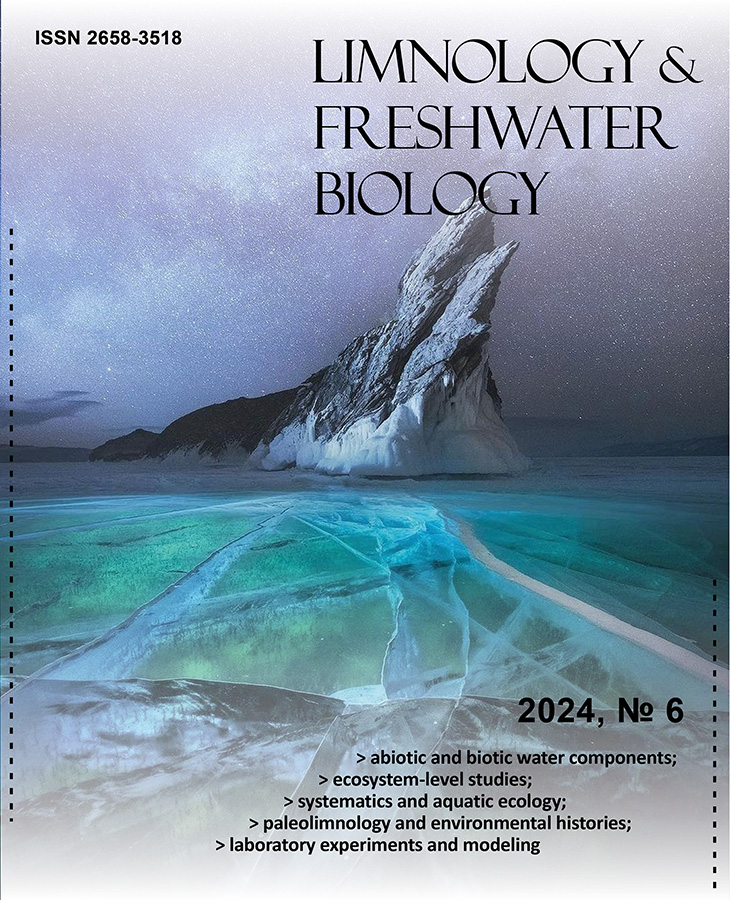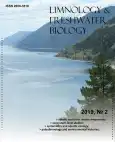Influence of food on morphological characteristics of Daphnia galeata (Cladocera, Daphniidae) from Lake Baikal
- Авторы: Pitul’ko S.I.1
-
Учреждения:
- Limnological Institute of the Siberian Branch of the Russian Academy of Sciences
- Выпуск: № 2 (2019)
- Страницы: 199-204
- Раздел: Статьи
- URL: https://journal-vniispk.ru/2658-3518/article/view/292307
- DOI: https://doi.org/10.31951/2658-3518-2019-A-2-199
- ID: 292307
Цитировать
Полный текст
Аннотация
The study shows the influence of feeding conditions on morphological characteristics of Daphnia galeata (Sars, 1863) in different areas of Lake Baikal. At high food concentrations and in the absence of invertebrate predators of the species Leptodora kindti, the daphnids have a large body size, low helmets and short tail spines. At low food concentrations, crustaceans with small-sized shells, poorly developed helmets and tail spines dominate. In the presence of the predators, an abrupt shift of adaptive variation occurs: at low food concentrations, the crustaceans have a large body size, and at high ones, small adult daphnids with well developed protective patterns dominate.
Ключевые слова
Об авторах
S. Pitul’ko
Limnological Institute of the Siberian Branch of the Russian Academy of Sciences
Автор, ответственный за переписку.
Email: pitulko@inbox.ru
Россия, Ulan-Batorskaya 3, 664033 Irkutsk
Список литературы
- Antipova N.L. 1963. Seasonal and annual variations in Lake Baikal phytoplankton. In: Trudy Baikalskoi limnologicheskoi stantsii AN SSSR [Proceedings of the Baikal Limnological Station of the Academy of Sciences of the USSR], pp. 12–18. (in Russian)
- Bondarenko N.A., Grachev M.A., Zemskaya T.I., Logacheva N.F., Levina O.V. 1991. ATP content in microplankton of certain regions of Lake Baikal. Soviet Journal of Ecology 22: 380–387.
- Bondarenko N.A., Obolkina L.A., Mel’nik N.G., Zemskaya T.I., Logacheva N.F. 1995. Interspecific links and structure of planktonic communities. 1.2. Phytoplankton. In: Timoshkin O.A. (Ed.), Guide and key to pelagical animals of Baikal (with ecological notes). Novosibirsk, pp. 60–61. (in Russian)
- Boersma M., Vijverberg J. 1996. Food effects on life history traits and seasonal dynamics of Ceriodaphnia pulchella. Freshwater Biology 35: 25–34.
- Brooks J.L. 1946. Cyclomorphosis in Daphnia I. An Analysis of a D. retrocurva and D. galeata. Ecological Monographs 16: 409–447.
- Burns C.W. 1995. Effect of crowding and different food levels on growth and reproductive investment of Daphnia. Oecologia [Ecology] 101: 234–244.
- Czeczuga B., Kozłowska M., Kiziewicz B. 2003 Effect of various types of phytoplankton on fertility, egg size and duration of postembryonic growth of a few plankton representatives of Cladocera (Crustacea). Polish Journal of Environmental Studies 12: 545–555.
- Dodson S.I. 1988 Cyclomorphosis in Daphnia galeata mendotae Birge and D. retrocurva Forbes as a predator-induced response. Freshwater Biology 19: 109–114. doi: 10.1111/j.1365-2427.1988.tb00332.x
- Dodson S.I. 1989. The ecological role of chemical stimuli for the zooplankton: predator-induced morphology in Daphnia. Oecologia [Ecology] 78: 361–367.
- Freese H.M., Martin-Creuzburg D. 2013. Food quality of mixed bacteria–algae diets for Daphnia magna. Hydrobiologia 1: 63–76.
- Garbutt J.S., Little T.J. 2014. Maternal food quantity affects offspring feeding rate in Daphnia magna. Biology Letters 10: 1–15. doi: 10.1098/rsbl.2014.0356
- Gall A., Kainz M.J., Rasconi S. 2017. Daphnia magna fitness during low food supply under different water temperature and brownification scenarios. Journal of Limnology 76: 161–169. doi: 10.4081/jlimnol.2016.1450
- Gilyarov A.М. 1987. Dynamics of the abundance of freshwater planktonic crustaceans. Moscow: Nauka. (in Russian)
- Gorbi G., Moroni F., Sei S., Rossi V. 2011. Anticipatory maternal effects in two different clones of Daphnia magna in response to food shortage. Journal of Limnology 70: 222–230. doi: 10.3274/JL11-70-2-05
- Jacobs J. 1987. Cyclomorphosis in Daphnia. Memorie dell’Istituto Italiano di Idrobiologia [Memories of the Italian Institute of Hydrobiology] 45: 325–352.
- Jeyasingh P.D., Weider L.J. 2005. Phosphorus availability mediated plasticity in life-history traits and predator-prey interaction in Daphnia. Ecology Letters 10: 1021–1028. doi: 10.1111/j.1461-0248.2005.00803.x
- Havel J.E. 1985. Cyclomorphosis of Daphnia pulex spined morphs. Limnology and Oceanography 30: 853–861.
- Havel J.E., Dodson S.I. 1985. Environmental cues for cyclomorphosis in Daphnia retrocurva. Freshwater Biology 15: 469–478.
- Hülsmann S., Rinke K., Mooij W.M. 2011. Size-selective predation and predator-induced life-history shifts alter the outcome of competition between planktonic grazers. Functional Ecology 25: 199–208. doi: 10.1111/j.1365-2435.2010.01768.x
- Hutchinson G.E. 1967. A treatise on limnology. Volume II. Introduction to lake biology and the limnoplankton. New York-London-Sydney: John Wiley and Sons.
- Korzun V.M., Pitul’ko S.I. 2010. Phenotypic variation and adaptive reaction to the presence of predator in two Daphnia species (Daphniiformes, Daphnia) in Lake Baikal. Russian Journal of Ecology 41: 316–321. doi: 10.1134/S1067413610040065
- Laforsh Ch., Tollrian R. 2004. Extreme helmet formation in Daphnia cucullata induced by small-scale turbulence. Journal of Plankton Research 26: 81–87. doi: 10.1093/plankt/fbg114
- Lagergren R., Svensson J.-E., Stenson J.A.E. 2007. Models of ontogenetic allometry in cladoceran morphology studies. Hydrobiologia 594: 109–116.
- Manca M., Vijverberg J., Polishuk V., Voronov D.A. 2008. Daphnia body size and population dynamics under predation by invertebrate and fish predation in Lago Madjiore approach based on contribution analysis. Journal of Limnology 67: 15–21.
- Manuylova E.F. 1964. Cladocera of the fauna in the USSR. Keys to the USSR fauna, published by the Zoological Institute of the USSR Academy of Sciences 88. Moscow-Leningrad: Nauka Publishers. (in Russian)
- Monakov A.I. 1998. Feeding of freshwater invertebrates. Moscow: Institute of Ecology and Evolution RAS. (in Russian)
- Masclaux H., Bec A., Kainz M.J., Desvilettes C., Jouve L., Bourdier G. 2009. Combined effects of food quality and temperature on somatic growth and reproduction of two freshwater cladocerans. Limnology and Oceanography 4: 1323–1332. doi: 10.4319/lo.2009.54.4.1323
- Pitul’ko S.I., Yermakov Ye.L., Korzun V.M. 2009. Variability of Daphnia clonal cultures by a set of quantitative features under contrast feeding conditions. Izvestiya Irkutskogo Gosudarstvennogo Universiteta. Seriya “Biologiya, Ecologiya” [The Bulletin of Irkutsk State University. Series “Biology, Ecology”] 2: 83–86. (in Russian)
- Pitul’ko S.I., Korzun V.M. 2010. Study of cyclomorphosis in two baikalian daphniid species. Baykal’skiy Zoologicheskiy Zhurnal [Baikal Zoological Journal] 5: 10–19. (in Russian)
- Ranta E., Tjossem S. 1987. Size and shape of Daphnia longispina in rock pool. Hydrobiologia 145: 259–268.
- Ranta E., Bengtsson J., McManus J. 1993. Growth, size and shape of Daphnia longispina, D. magna and D. pulex. Annales Zoologici Fennici 30: 299–311.
- Riccardi N., Giussani G., Lagorio L. 2002. Morphological variation and life history changes of a Daphnia hyalina population exposed to Chaoborus flavicans larvae predation (L. Candia, Northern Italy). Journal of Limnology 61: 41–48. doi: 10.4081/jlimnol.2002.41
- Rinke K., Petzoldt Th. 2003. Modeling the effects of temperature and food on individual growth and reproduction of Daphnia and their consequences on the population level. Limnologica 4: 229–376. doi: 10.1016/S0075-9511(03)80024-5
- Rokitskii P.F. 1973. Biological statistics. Minsk: Vysshaya Shkola. (in Russian)
- Romanovsky Yu. E. 1989. Сompetition for fluctuating resource: an evolutionary ecological study. Zhurnal obshchei biologii [Biology Bulletin Reviews] 3: 304–314. (in Russian)
- Sarpe D., de Senerpont Domis L.N., Declerck S.A.J., Donk E., Ibelings B.W. 2014. Food quality dominates the impact of food quantity on Daphnia life history: possible implications for re-oligotrophication. Inland Waters 4: 363–368. doi: 10.5268/IW-4.4.701
- Sheveleva N.G. 1996. The species composition and distribution of cladocerans in Lake Baikal. Zoologicheskiy Zhurnal [Biology Bulletin] 75: 312–315. (in Russian)
- Sheveleva N.G. 2001. Cladocera (Ctenopoda, Anamopoda, Haplopoda, Onychopoda). In: Annotated list of fauna of Lake Baikal and of its water catchment basin. Vol. 1: Lake Baikal. Novosibirsk, pp. 491–496. (in Russian)
- Schultz K.L., Sterner R.W. 1999. Phytoplankton phosphorus limitation and food quality for Bosmina. Limnology and Oceanography 6: 1549–1556. doi: 10.4319/lo.1999.44.6.1549
- Sicora A.B., Dawidowicz P., von Elert E. 2014. Daphnia fed algal food grown at elevated temperature have reduced fitness. Journal of Limnology 3: 421–427. doi: 10.4081/jlimnol.2014.898
- Tams V., Lüneburg J., Seddar L., Detampel Jan-Phillip., Cordellier M., 2018. Intraspecific phenotypic variation in life history traits of Daphnia galeata populations in response to fish kairomones. PeerJ 6. doi: 10.7717/peerj.5746
- Vijverberg J. 1976. The effect of food quantity and quality on the growth, birth rate and longevity of Daphnia hyalina Leydig. Hydrobiologia 51: 99–108.
- Zhukova N.A. 1953. Cyclomorphosis in daphnia. Trudy Leningradskogo pedagogicheskogo instituta [Proceedings of the Leningrad Pedagogical Institute] 7: 85–148. (in Russian)
- Zuykova E.I., Bochkarev N.A. 2010. Postembryonal morphological variation of Daphnia galeata in water bodies of different types. Contemporary Problems of Ecology 3: 28–40. doi: 10.1134/S1995425510010066
Дополнительные файлы










